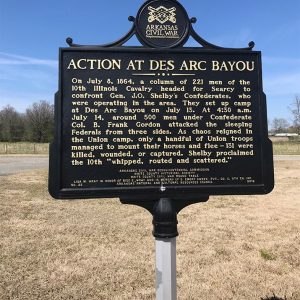calsfoundation@cals.org
Action at Des Arc Bayou
| Location: | White County |
| Campaign: | None |
| Date: | July 14, 1864 |
| Principal Commanders: | Captain David H. Wilson (US); Colonel B. Frank Gordon, (CS) |
| Forces Engaged: | Tenth Illinois Cavalry Regiment (detachment) (US); Shelby’s Confederate Cavalry (detachment) (CS) |
| Estimated Casualties: | 131 (US); None reported (CS) |
| Result: | Confederate victory |
The Action at Des Arc Bayou was fought in the early morning hours of July 14, 1864, as a detachment of Brigadier General Joseph O. Shelby’s Missouri cavalry attacked the camp of a detachment from the Tenth Illinois Cavalry that had set out to confront and harass Shelby’s troops in northeastern Arkansas.
Shelby had taken control of all Confederate forces in northeast Arkansas in May 1864, and his troops had been raiding throughout the region, destroying a Union garrison at Dardanelle (Yell County), sinking the U.S. gunboat Queen City as it lay at anchor at Clarendon (Monroe County), and attacking trains on the Memphis to Little Rock Railroad that ran troops and supplies between the Arkansas capital and the large Federal base at DeValls Bluff (Prairie County). Union commanders began aggressively patrolling in an effort to stop Shelby’s attacks. A column from Lewisburg (modern-day Morrilton in Conway County) on July 8, 1864, attacked a group in Searcy County that was organizing to join Shelby, killing seven, wounding four, and capturing fifty-five men. Scouts from the Tenth Illinois Cavalry killed and wounded five other Confederate recruits a day later.
On July 8, 1864, a column of around 250 troopers of the Tenth Illinois under Captain David H. Wilson moved out from Little Rock (Pulaski County) to occupy Searcy (White County) and confront Shelby’s forces. Four days later, Shelby sent out three raiding parties to attack the railroad, including five hundred under Colonel B. Frank Gordon. Gordon found that Davis’s Illinoisans were camped at Bayou Des Arc on July 13 and decided to attack.
The Confederates hit the slumbering camp of the Tenth Illinois at 4:30 a.m. on July 14. Gordon split his command into three groups, with two attacking dismounted from the front and rear of the camp while the third remained on horseback and moved in from the Illinoisans’ left flank. Wilson’s bugler sounded “to horse” as the attack began, but many of the Northerners were killed or captured as they tried to mount their horses in the chaos of the surprise assault. Wilson then ordered his men to dismount and fall back to the bayou to fight on foot, but they were hammered by volleys from Rebels who had crossed the bayou and were firing from its south bank. Seeing Confederates closing in from his right and left, Wilson ordered his men to get on their horses and fight their way out of the closing pincers of the Confederate attack. The survivors of the Tenth Illinois straggled into Brownsville (north of modern-day Lonoke in Lonoke County) that afternoon.
Wilson reported that he lost 131 of the 221 men and officers who were in the camp at Des Arc Bayou, in addition to his ambulance and its horses. Shelby actually underreported the Federal losses, claiming twenty killed and eighty-seven captured along with a loaded six-mule supply wagon, the ambulance, and 200 cavalry weapons. He proudly reported that “this boasted regiment…was whipped, routed, and scattered, and only saved from utter annihilation by the superior quality of its horses.” Shelby and his men continued pestering the Union troops in east Arkansas through the summer, culminating their attacks with the devastating assault on Ashley’s Station and the Memphis to Little Rock Railroad in August.
For additional information:
Christ, Mark K. “The Queen City Was a Helpless Wreck: J. O. Shelby’s Summer of ’64.” In The Earth Reeled and Trees Trembled: Civil War Arkansas 1863–1864, edited by Mark K. Christ. Little Rock: Old State House Museum, 2007.
Edwards, John N. Shelby and His Men: Or, the War in the West. Waverly, MO: General Joseph Shelby Memorial Fund, 1993.
The War of the Rebellion: A Compilation of the Official Records of the Union and Confederate Armies. Series 1, vol. 41. Washington DC: Government Printing Office, 1890–1901, p. 15–16, 26–28.
Mark K. Christ
Little Rock, Arkansas








Comments
No comments on this entry yet.